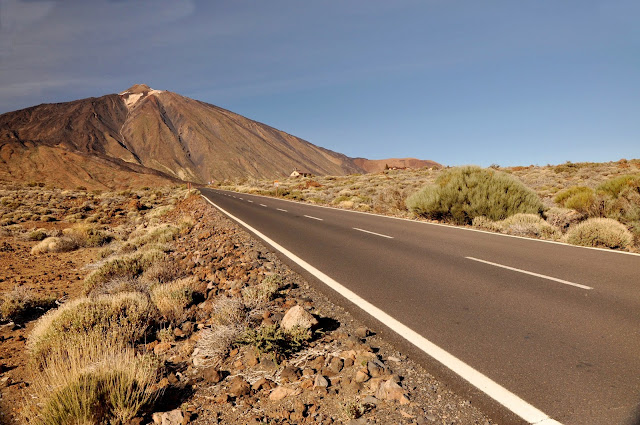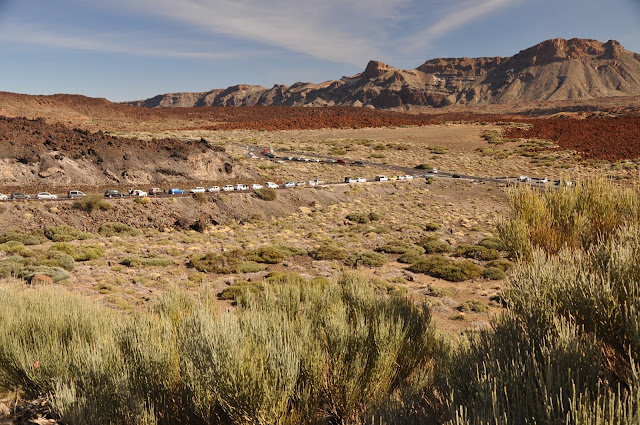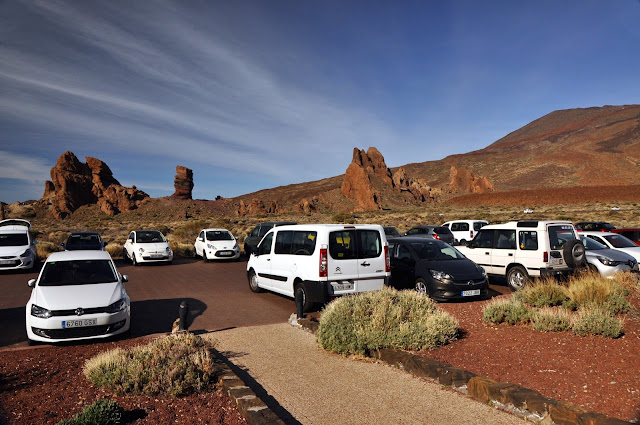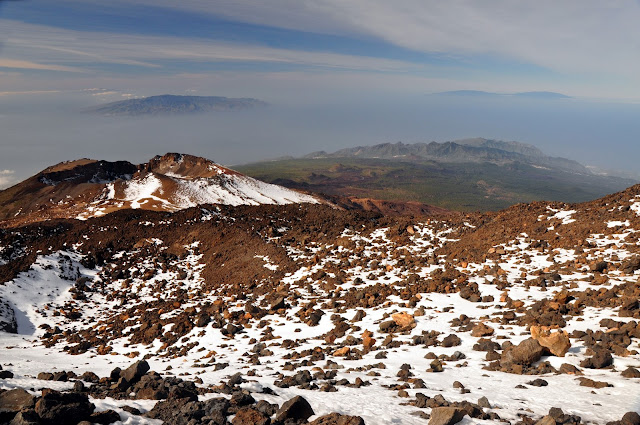The
next day I decided to pay a visit to the dormant volcano, Teide. Located at the
center of Tenerife, this volcano is a treat for researchers in the field of
geology and biodiversity. I boarded a bus from Los Christianos, a city on the
southern coast of Tenerife and set off towards the volcano. This road from the
southern coast presents an ever-changing exciting collage of scenic geological
vistas. At times the street was lined with multi-colored rocks and shrubs,
while at other times it was lined with dense pine forests immersed in fog.
Suddenly the bus entered a mountain pass. On emerging out of the pass, the main
peak of Teide could be seen rising directly in the front.
next day I decided to pay a visit to the dormant volcano, Teide. Located at the
center of Tenerife, this volcano is a treat for researchers in the field of
geology and biodiversity. I boarded a bus from Los Christianos, a city on the
southern coast of Tenerife and set off towards the volcano. This road from the
southern coast presents an ever-changing exciting collage of scenic geological
vistas. At times the street was lined with multi-colored rocks and shrubs,
while at other times it was lined with dense pine forests immersed in fog.
Suddenly the bus entered a mountain pass. On emerging out of the pass, the main
peak of Teide could be seen rising directly in the front.
 |
| The road that goes towards Teide |
During
the final stages of eruption, the region around the main peak sunk due to
tectonic movements, which resulted in the formation of a massive crater nearly
16 km x 9 km in area. Large trees do not grow in this area. However, plants
that thrive in arid area are abundant here. Because of its unique environment
many endemic plants are found here. Teide White Broom, Teide Daisy and Teide
Violet are some of the endemic plants found here. In spring, there is a riot
bloom of plant life. A number of tourist throng here to have a look at the
blooms. Since the eruption took place in phases, it has created many enchanting
landscapes. Some regions resemble the lunar surface; other regions give one the
impression of being on Mars. Teide and its surrounding area is protected by the
Government of Spain as a national park. Besides, it has also been declared as a
world heritage site by UNESCO.
the final stages of eruption, the region around the main peak sunk due to
tectonic movements, which resulted in the formation of a massive crater nearly
16 km x 9 km in area. Large trees do not grow in this area. However, plants
that thrive in arid area are abundant here. Because of its unique environment
many endemic plants are found here. Teide White Broom, Teide Daisy and Teide
Violet are some of the endemic plants found here. In spring, there is a riot
bloom of plant life. A number of tourist throng here to have a look at the
blooms. Since the eruption took place in phases, it has created many enchanting
landscapes. Some regions resemble the lunar surface; other regions give one the
impression of being on Mars. Teide and its surrounding area is protected by the
Government of Spain as a national park. Besides, it has also been declared as a
world heritage site by UNESCO.
 |
| The landscape around Teide |
 |
| The bus stop at the base of Teide |
Winding
itself along the curves through such an enchanting region the bus eventually
reached the foot of the volcano. The foot of the volcano itself is at a height
of 2350 meters. There is a cable car facility that takes you close to the
summit. But even the cable car does not take you near the summit. The final 200
meters has to be climbed on foot. However, this ascent can only be done with a government
licensed and recognized guide with prior booking and registration. Due to the
extremely sensitive nature of the ecology at the very top of the summit, there
are limitations on its access. In December, these heights were covered in snow.
Hence, the route leading from the cable car station to the top was closed.
However, we were permitted to wander around in the surrounding areas. From the
top, in a single glance, it was possible to see the entire Tenerife island, the
surrounding azure sea as well as other islands of the Canary Island group. As
luck would have it, the sky and the air was clear. So, after carrying out a bit
of photography, I started on my way down the mountain.
itself along the curves through such an enchanting region the bus eventually
reached the foot of the volcano. The foot of the volcano itself is at a height
of 2350 meters. There is a cable car facility that takes you close to the
summit. But even the cable car does not take you near the summit. The final 200
meters has to be climbed on foot. However, this ascent can only be done with a government
licensed and recognized guide with prior booking and registration. Due to the
extremely sensitive nature of the ecology at the very top of the summit, there
are limitations on its access. In December, these heights were covered in snow.
Hence, the route leading from the cable car station to the top was closed.
However, we were permitted to wander around in the surrounding areas. From the
top, in a single glance, it was possible to see the entire Tenerife island, the
surrounding azure sea as well as other islands of the Canary Island group. As
luck would have it, the sky and the air was clear. So, after carrying out a bit
of photography, I started on my way down the mountain.
 |
| The view from the summit of Teide. The islands La Palma and La Gomera can be seen at a far distance |
The
next day I had to change my hostel. Hence, that evening I spent in El Medano, and
packed my belongings.
next day I had to change my hostel. Hence, that evening I spent in El Medano, and
packed my belongings.
The
next two days were planned to be spent on the North of the island. Accordingly,
I embarked on my journey to Santa Cruz de Tenerife. This is the largest and the
capital city of Tenerife. Hence, shopping malls, theaters, expansive gardens,
restaurants offering international cuisine and a glut of other modern amenities
are found in abundance. The auditorium, located on the beach is famous for its
unique architecture. Its design creates an impression of the Sydney Opera. After
a leisurely evening stroll along the beach, I returned to the hostel.
next two days were planned to be spent on the North of the island. Accordingly,
I embarked on my journey to Santa Cruz de Tenerife. This is the largest and the
capital city of Tenerife. Hence, shopping malls, theaters, expansive gardens,
restaurants offering international cuisine and a glut of other modern amenities
are found in abundance. The auditorium, located on the beach is famous for its
unique architecture. Its design creates an impression of the Sydney Opera. After
a leisurely evening stroll along the beach, I returned to the hostel.
For more pictures click here.